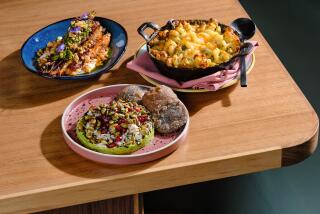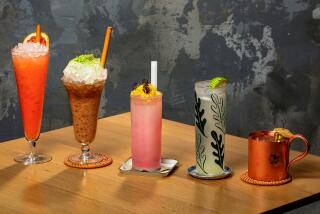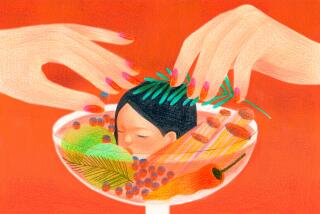Old New Orleans’ Quest for Cool
Savage summers bore down on 19th Century New Orleans with a vengeance. Many years before the advent of air conditioning and pest control, women fainted in piles of petticoats, and mosquitoes were so thick that their swarms often looked like fog. Smudge pots burned to fight yellow fever and French Quarter streets steamed under heaps of debris.
There were few alternatives to the extreme discomforts of summer in New Orleans. Some Creoles escaped to the country, though others were forced to stay in the city. Making the best of it, they transformed their houses with “summer dress,” covering their furnishings in white fabric and net, and storing the heavy velvet draperies and other winter items. A scaling-down of menus was accompanied mercifully by daily shipments of ice from the north; thus came the salvation of cooling summer drinks.
Cherry bounce, iced lemonade, strawberry ratafia and milk punch were typical in the lineup of refreshing liquids the Creoles enjoyed from dawn to dark.
At Houmas House, it is recorded, mint juleps were served in the mornings before breakfast for sipping during the bath. Often, the bath as well as the drink contained ice cubes. And at Gallier House, a typical 19th-Century French Quarter home on Royal Street, the famous architect’s family sipped different drinks all day long, from ice water to fruit ades to iced cordials and wine punches.
Tons of ice were unloaded daily from barges on the Mississippi River and sold in the streets. At Gallier House, the ice box was located far away from the kitchen to prevent the heat generated there from melting the precious commodity.
“There were lots of recipes for cold dishes that used leftovers,” says Ann M. Masson, executive director of Gallier House. In the heat of summer, whatever means necessary to avoid firing up the open hearth were taken, and drink and food preparation changed complexion along with the scenery.
Wild cherries, elderberry bushes and strawberries were the sources of many great drinks. But while New Orleanians suffered mightily from the heat, they had access to imports of all kinds.
“New Orleans was an extremely cosmopolitan place at the time,” Masson says. Since it was a port city, residents had access to European imports of food and wine as well as commodities from other American cities.
Citrus was readily available, having been shipped as a major preventive of scurvy. Cookbook authors of the time “wrote lots of lemon recipes,” Masson says. And lemons and limes traveled well, compared to softer fruits such as bananas and peaches.
Alcoholic drinks, especially wines and cordials, were popular at meals and throughout the day. Very strong cordials were consumed as a digestive aid before or after dinner.
While men frequented restaurants and bars, women were more prone to visit ice cream parlors, and some primitive ice cream freezers were used for making sherbets and ice creams at home.
Ratafias were beverages loved by the Creoles. More easily prepared than cordials, they were usually made of Louisiana fruits and a good French brandy; sometimes they contained nuts and flowers.
Fruit waters were served to visitors in the evenings and at summer receptions and reunions. Made of fruit juices and syrups, these waters sometimes included coffee and were usually swirled on ice until frozen. Unlike the ratafias , they were served soon after concoction. Granites were slushy frozen fruit drinks, favorites in France and New Orleans.
Milk punch was a breakfast drink, and like many of the old favorites, it has carried over and remains popular in New Orleans restaurants today.
At Gallier House, now a museum open to the public, many of the old utensils used to make special drinks occupy shelves in the kitchen and dining room. A cypress ice box appears in its proper place on the gallery, away from the kitchen and from the fine flooring that drips could have ruined.
*
The cherry bounce has been popular in New Orleans for two centuries. From a 19th-Century cookbook (“Directions for Cookery,” by Miss Leslie, 1844) comes this description, followed by a more modernized version that is used today.
“Mix together 6 pounds of ripe morellos and 6 pounds of large black - heart cherries. Put them into a wooden bowl or tub, and with a pestle or mallet, mash them so as to crack all the stones. Mix with the cherries 3 pounds of loaf sugar, or of sugar candy broken up, and put them into a demijohn, or into a large stone jar. Pour on 2 gallons of best double - rectified whiskey. Stop the vessel closely and let it stand 3 months, shaking it every day during the first month. At the end of the 3 months you may strain the liquor and bottle it off. It improves by age.”
SEN. ALLEN J. ELLENDER’S CHERRY BOUNCE 3 quarts wild cherries Grain alcohol or bourbon 3 pounds sugar
Wash and stem cherries and place in 1-gallon container. Fill with grain alcohol. Let stand 14 days, shaking jar occasionally. Strain off.
Make syrup by placing 3 pounds sugar in 1/2 gallon measure and adding water to fill. Bring syrup to good boil. Cool and add to juice. (To each 1/2 gallon juice, add 1/2 gallon syrup.) Bottle and seal. Makes 1 gallon.
*
This recipe comes from “The Original Picayune Creole Cook Book” (1901, New Orleans).
ICED LEMONADE 1 dozen lemons Crushed sugar cubes 2 cups sugar 2 1/2 quarts water Crushed ice
Choose finest and freshest ripe lemons. Rasp zest with white, crushed sugar, in order to extract fine aromatic oil in skin. Then squeeze lemons and strain juice. Add sugar and water.
Place rasped zest in each glass and serve with crushed ice. Makes 12 servings.
Note: In making lemonade, never use zests of lemons, except to slice 1 and place in glass when about to serve. Zest put into lemonade does not add to strength, but imparts bitter flavor.
*
This recipe also appeared in “The Original Picayune Creole Cook Book” and was named in honor of the newspaper’s weather prophet, a frog pictured daily with the weather report. This famous drink was originated for a charity festival given in New Orleans for the benefit of the Newsboys’ Home.
PICAYUNE FROG LEMONADE 1 pineapple 2 dozen lemons 1 pound sugar 2 quarts water 2 bottles seltzer water 3 dozen large strawberries 1 lemon, thinly sliced Crushed ice
Extract juice from pineapple, reserving few slices for garnish. Cut and juice lemons. Pour lemon juice into large punch bowl along with pineapple juice, sugar, water and seltzer water. Mix well. Add strawberries and decorate with slices of pineapple and lemon. Sweeten with sugar to taste.
Place large piece of ice in bowl. When ready to serve, fill glass 1/4 full of crushed ice and fill up with lemonade. Garnish with strawberries and lemon and pineapple slices in each glass.
*
Another favorite from “The Original Picayune Creole Cook Book.”
MILK PUNCH 1 tablespoon whiskey or brandy 1 tablespoon sugar 1 glass of milk Crushed ice Ground nutmeg
Combine whiskey and sugar and stir until sugar is dissolved. Pour mixture over milk. Add small quantity of crushed ice and sprinkle with ground nutmeg. Makes 1 serving.
More to Read
Sign up for Essential California
The most important California stories and recommendations in your inbox every morning.
You may occasionally receive promotional content from the Los Angeles Times.










